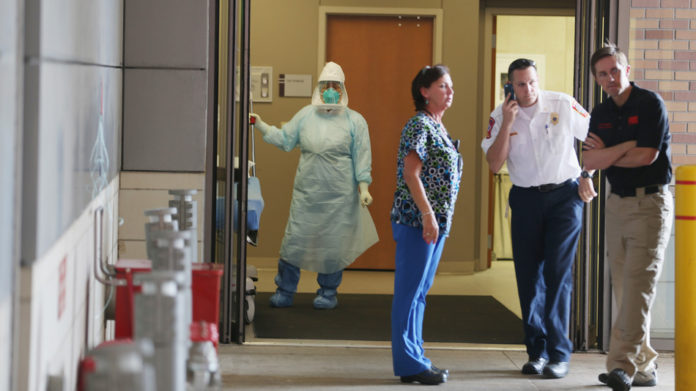Texas Ebola Nurses Wore Too Much Protective Gear

As Thomas Eric Duncan’s health deteriorated, nurses Amber Joy Vinson and Nina Pham were at the Ebola patient’s side.
They wore protective gear including face shields, hazardous materials suits and protective footwear as they inserted catheters, drew blood and dealt with his body fluids. Still, the two somehow contracted Ebola from the dying man.
As health officials try to figure out how that happened, the nurses’ cases have brought new scrutiny to national Ebola protocols that had never before been put to the test at a general hospital. Authorities are examining whether those guidelines need to be rewritten.
The federal Centers for Disease Control and Prevention protocols for Ebola recommend that nurses use personal protective equipment such as gloves, goggles, face shields and fluid-resistant gowns — as Vinson and Pham did. They also recommend diligent cleaning and disinfection of any items containing contaminated materials.
CDC director Dr. Tom Frieden has cited a “breach in protocol” that allowed Pham to be infected while she cared for Duncan in the intensive care unit, but has not specified the nature of that breach. He did however note that some of Texas Health Presbyterian Hospital nurses inadvertently violated the CDC protocols by wearing too much protective gear.
“These are good, dedicated people who worried about themselves and their families and they were trying to protect themselves better, but in fact by putting on more layers of gloves or other protective clothing, it becomes much harder to put them on, it becomes much harder to take them off,” Frieden said Wednesday.
“And the risk of contamination during the process of taking these gloves off gets much higher. That’s true for several different areas of the body,” he added.

Bellevue Hospital nurses pose in protective suits in an isolation room during a demonstration of procedures for possible Ebola patients on Oct. 8, 2014.
Image: Richard Drew/Associated Press
Online, the CDC sought Wednesday to clarify the Ebola protocols in a health care setting, adding specifics on a website about double-gloving and restricting the number of caregivers involved. These are recommendations, not requirements. More than 75 people were identified as being involved in Duncan’s care, including the now-sick nurses.
Pham, 26, is being treated at the Dallas hospital and is in good condition. Vinson, 29, who tested positive Wednesday, has been transferred to a high-level biohazard infectious disease center at Emory University Hospital in Atlanta.
Duncan’s medical records, provided to The Associated Press by his family, note that after he was placed in isolation in the intensive care unit, Pham and Vinson were among the nurses actively engaged in his care.
On Oct. 1, Pham wrote in her morning progress note that two nurses entered Duncan’s room wearing Tyvek suits, respirators, triple booties, triple gloves and an apron. Her report describes nurses repositioning Duncan and providing emotional support. They also mopped the floor with bleach and wiped down surfaces. He said he was feeling better and asked to watch an action movie.
Vinson was with him Sept. 30, the day he tested positive for Ebola. The reports say she too wore protective gear and a face shield, hazardous materials suit and protective footwear. At the time, Duncan’s body fluids were highly infectious. He had “extremely watery diarrhea,” a fever of 102.7 and severe stomach pain. An hour later, Vinson inserted a catheter.
Early the next morning she came in again, again wearing the protective gear as well as a respirator mask. Later that night she cared for him again, with similar protection and with Duncan exhibiting similar symptoms.
The evening before Duncan died, Vinson was at his bedside. She wrote that she wore full protective gear as she gave him a bag of saline in an IV.
Safety rules have evolved since Ebola was first recognized in 1976 in Zaire. And while there is still no cure, the World Health Organization and Doctors Without Borders have developed relatively safe ways to care for people during many large and deadly outbreaks in Africa over the past four decades.
But Ebola is a new phenomenon in the U.S., providing an opportunity for health officials to revise protocols.

“We need to find out why this transmission occurred, lay open the possibility that the protocol may be inadequate,” said Dr. Pascal James Imperato, dean of SUNY’s Downstate Medical Center school of public health.
The current outbreak, the largest in history, is blamed not on protocol violations but on a lack of care. About 70 percent of those who get Ebola are dying, according to WHO’s most recent estimates. The virus has killed almost 4,500 people, most of them in West Africa.
Duncan, the first person diagnosed with Ebola in the U.S., was placed on a ventilator and had dialysis during his 10-day stay at Texas Health Presbyterian. Both procedures could have exposed caregivers to risks that don’t occur at more basic clinics in Africa where protocols have largely worked.
Duncan was initially misdiagnosed when he first went to the Dallas emergency room and was sent home with antibiotics. That, along with his Oct. 8 death and the infection of the nurses, have prompted medical authorities to “rethink the way we address Ebola infection control, because even a single infection is unacceptable,” Frieden said.
In a letter to President Barack Obama on Wednesday, National Nurses United executive director RoseAnn DeMoro called for new mandates that go beyond existing CDC protocols: full-body hazmat suits, at least two nurses assigned to each Ebola patient and continuous training.
Terry O’Sullivan, who directs University of Akron’s center for emergency management, said he expects any new U.S. patients to be transported to one of four federally supported Care and Isolation Units associated with the National Institutes of Health, in part because those additional precautions including the moon suits are already in place.
Have something to add to this story? Share it in the comments.
